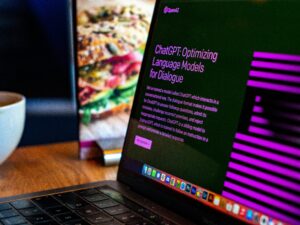
Photo by Solen Feyissa on Unsplash
For this week’s readings, I was able to read Bozkurt et al and Selwyn et al’s work, but was unable to access “Facing up to the dilemma of sustainable futures”. That being said, I enjoyed the readings and thought about the central theme between the two, which is about ethical and social responsibility when it comes to the future of EdTech. Selwyn et al’s article was insightful because it illustrated how systemic inequalities continue to shape who benefits from digital advancements (2019). I believe that the digitalization of education has been incredible for removing barriers to education because technically anyone can using it to learn about anything they want if they do enough research. Technology is incredibly convenient and helps students access information anytime anywhere. But with any technological innovation, they can perpetuate educational disparities by benefiting those with more resources and digital fluency. I have noticed that schools are addressing this by providing students with Macbooks at an early age, which is incredible because it means that students who don’t have the means to own technology equipment will have the opportunity to develop digital fluency at school. The article mentions something that really stuck out to me, which is the idea that classrooms could become extensions of corporate data farms, especially when decisions about educational tools are driven by private companies rather than public sectors (Selwyn et al, 2019, p.3). It does make me wonder, how do we make sure that educational tools serve students and the public good and not just market interest? The authors’ take on this question is stressing the importance of helping educators stay in control, rather than letting companies dictate how education evolves (Selwyn et al, 2019, p.4).
The other reading by Bozkurt et al complements Selwyn et al’s work by providing grounded examples of how AI is already reshaping learning in both higher education and K-12 (2023). It presents a more optimistic yet cautious view which is similar to my short presentation assignment where I discussed AI grading. We both came to similar conclusions, which is that Ai has immense potential to personalie learning and enhance student engagement, but only if it’s implemented thoughtfully and ethically. Concerns about bias and privacy aren’t just side notes, but structural issues that need to be addressed. The authors really go into this idea more though by calling a need for AI literacy and the development of new, creative assessment models to prepare both educators and students not just to use AI, but to critically engage with it (Bozkurt et al, 2023). Taking these readings in together, both readings suggest that the challenges of the 2020s is to shape emerging technologies in ways that reflect the needs and demands of our societies.
My personal thoughts on AI is that it is an incredible tool that can automate so many tasks and help redirect focus away from repetitive and meticulous tasks to more meaningful areas of work. I think it’s pointless to tell students to not use AI because:
- They absolutely will use it regardless, and restriction just results in sneakier students
- It denies students a valuable educational tool.

Photo by Emiliano Vittoriosi on Unsplash
Bozkurt et al’s work resonated with me because it acknowledges that instead of trying to control and restrict students, that we should try to work around emerging technologies and adapt to it. I believe this mindset has the potential to create positive, lasting changes in how we teach and learn, but only if AI is implemented thoughtfully and with clear purpose. Although I am not an educator myself, I’ve seen numerous videos and online posts from teachers who express concern that students are becoming overly reliant on AI tools. Some educators have observed that students struggle to engage in critical thinking or problem-solving independently, turning to AI for quick answers instead of working through the learning process.
However, if students are already using these tools, then the solution isn’t to ban or shame their use, but to guide it. We should focus on teaching students how to use AI responsibly and critically. Empowering students to engage with AI thoughtfully will better prepare them for a future where these technologies are deeply embedded in everyday life.
References
Bozkurt, A., Xiao, J., Lambert, S., Pazurek, A., Crompton, H., Koseoglu, S., Farrow, R., Bond, M., Nerantzi, C., Honeychurch, S., Bali, M., Dron, J., Mir, K., Stewart, B., Costello, E., Mason, J., Stracke, C. M., Romero‑Hall, E., Koutropoulos, A., Toquero, C. M., Singh, L., Tlili, A., Lee, K., Nichols, M., Ossiannilsson, E., Brown, M., Irvine, V., Raffaghelli, J. E., Santos‑Hermosa, G., Farrell, O., Adam, T., Thong, Y. L., Sani‑Bozkurt, S., Sharma, R. C., Hrastinski, S., & Jandrić, P. (2020). What’s next for Ed‑Tech? Critical hopes and concerns for the 2020s. Learning, Media and Technology, 45(1), 1–6. https://doi.org/10.1080/17439884.2020.1694945
Selwyn, N., Hillman, T., Eynon, R., Ferreira, G., Knox, J., Macgilchrist, F., & Sancho-Gil, J. M. (2020). What’s next for Ed-Tech? Critical hopes and concerns for the 2020s. Learning, Media and Technology, 45(1), 1–6. https://doi.org/10.1080/17439884.2020.1694945
Hello Mandy!
Thank you for sharing your thoughts on AI use in educational spaces, I thought your arguments were very well laid out and properly supported. My favorite part about your post was how you stressed the need to embrace AI, instead of oppose it, to allow students to interact with the technology in a meaningful way. I believe you’re absolutely correct in saying that because AI is such attractive technology, it is unrealistic to ban students from using it. Nowadays AI can literally be found everywhere. As such, educators must pivot themselves to adapt to the technology and share how it can be used in truly helpful ways. We must begin to address the question of how we can use AI to elevate our critical thinking and analysis skills.
Regarding the formatting of your post, I enjoyed how you used visual media to break up your text and used the number/bulleting function to highlight certain points in your post. Using headings is also a great way to break up content to make it more digestible to readers! You mentioned some online discourse regarding teachers expressing their concern for students heavily relying on AI, I think it would have been great if you linked some of those for reference directly in your post.
Thank you again for your post, I appreciate your valuable insights 🙂
Hi Mandy!
Thank you for such insightful reflections! I really appreciate how you tied together the core messages of both articles, especially the tension between the benefits of edtech and the ethical complexities it brings. I was also struck by your observation that the classroom can become an “extension of the corporate data farm”. It’s a powerful reminder that whoever controls these tools benefits from them.
Your stance on AI is refreshing – I completely agree that banning AI is ineffective and even counterproductive. Instead, the solution lies in critical AI literacy, and students and teachers alike should learn how to use these tools carefully, rather than relying on them blindly. The point about the need for new assessment models especially resonates with me – in a world where AI is at our fingertips, we can no longer assess students in the same way.
Thanks again for sharing your thoughts – your post has given me a lot to think about, especially in terms of how we define “ethical use” and who makes those decisions.